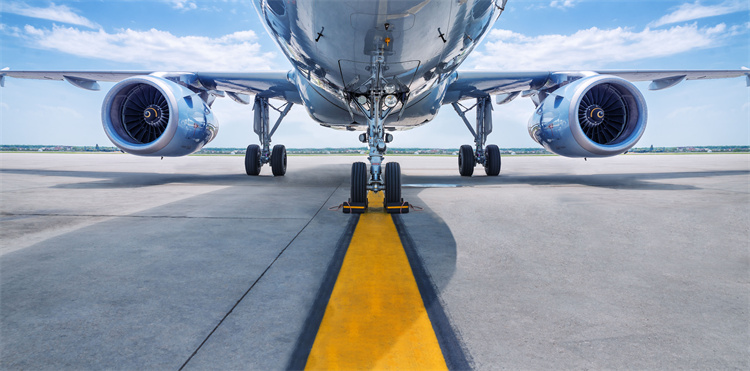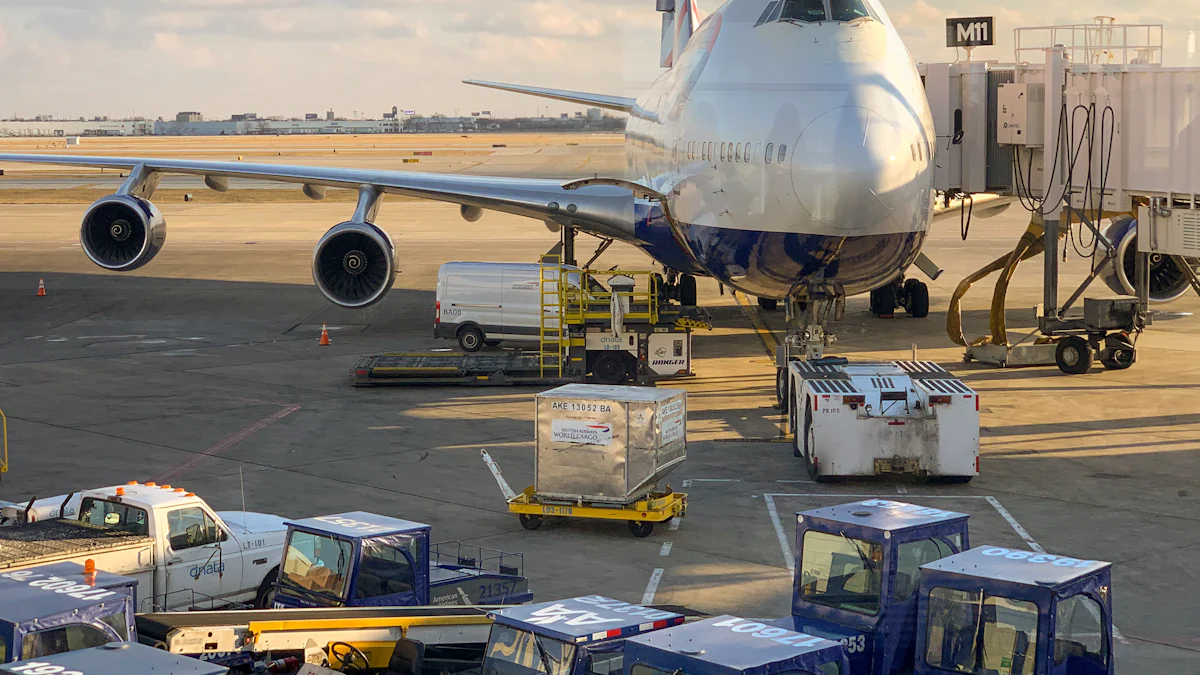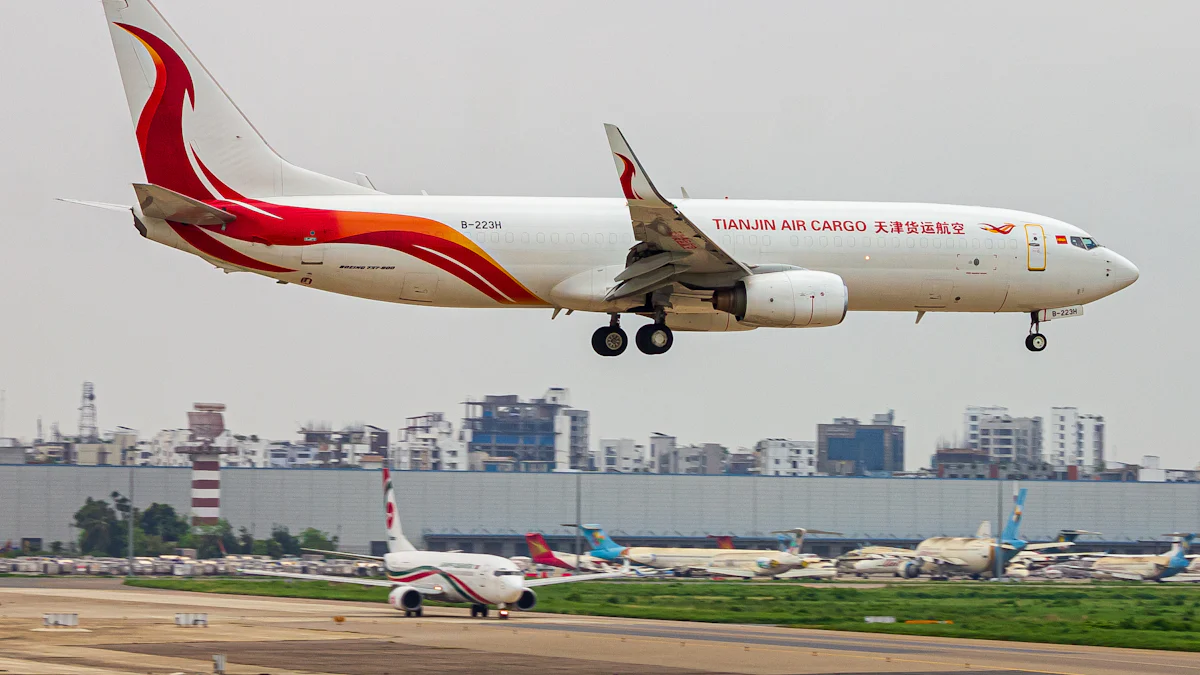Impact of Global Trade on China's Air Freight Market

Global trade plays a crucial role in the world economy. The exchange of goods and services across borders drives economic growth and fosters international cooperation. China has emerged as a significant player in this arena, particularly in the Air Freight sector. Over the past two decades, China's air freight market has seen rapid development, with continuous expansion in infrastructure and capabilities. Understanding the impact of global trade on this market is essential. This knowledge helps stakeholders make informed decisions and adapt to evolving trends.
Overview of Global Trade
Historical Context
Evolution of Global Trade
Trade has shaped human history for thousands of years. The Age of Exploration (15th to 17th centuries) marked a significant expansion in international trade routes. Explorers established new trade links and colonies, connecting distant markets. The Industrial Revolution (18th to 19th centuries) brought technological advancements. These innovations facilitated mass production and global trade on an unprecedented scale.
Globalization in the mid-20th century further transformed trade. Businesses focused on shipping and logistics to meet consumer demands swiftly and cost-effectively. This period saw the rise of complex international trade networks. For over 8,000 years, the desire for goods from distant lands has driven the evolution of these networks. Trade routes have left lasting imprints on cultures and markets worldwide.
Key Milestones in Trade Agreements
Trade agreements have played a crucial role in shaping global commerce. The General Agreement on Tariffs and Trade (GATT), established in 1947, aimed to reduce trade barriers. GATT laid the groundwork for the World Trade Organization (WTO), which emerged in 1995. The WTO continues to oversee international trade rules and resolve disputes.
Other significant milestones include the North American Free Trade Agreement (NAFTA), signed in 1994. NAFTA created a trilateral trade bloc between the United States, Canada, and Mexico. The European Union (EU) also established a single market, allowing free movement of goods, services, and people among member states. These agreements have fostered economic cooperation and growth.
Current Trends
Major Players in Global Trade
Several countries dominate global trade today. China, the United States, and Germany rank among the top exporters and importers. China's rapid economic growth has positioned it as a leading trade powerhouse. The United States maintains a significant presence due to its diverse economy and technological innovation. Germany excels in manufacturing, particularly in the automotive and machinery sectors.
Emerging economies like India and Brazil are also gaining traction. These countries are expanding their trade activities and increasing their influence in the global market. Multinational corporations play a vital role in driving trade. Companies like Apple, Samsung, and Volkswagen operate extensive supply chains that span multiple continents.
Trade Routes and Logistics
Efficient trade routes and logistics are essential for global commerce. The Suez Canal and the Panama Canal serve as critical chokepoints for maritime trade. These canals shorten travel distances and reduce shipping costs. Major sea routes connect Asia, Europe, and North America, facilitating the flow of goods.
Air freight has become increasingly important for high-value and time-sensitive products. Airports like Hong Kong International Airport and Memphis International Airport act as major air cargo hubs. Technological advancements in logistics, such as real-time tracking and automated warehouses, enhance efficiency. These innovations ensure that products reach consumers quickly and reliably.
"Trade is the engine of economic growth." - Peter Sutherland, former Director-General of the World Trade Organization
Understanding the historical context and current trends in global trade provides valuable insights. These insights help stakeholders navigate the complexities of international commerce.
China's Air Freight Market

Market Structure
Key Players in the Market
China's Air Freight market features a mix of established leaders and new entrants. Companies like China Airlines Cargo dominate the landscape. These firms leverage robust resources and market influence to drive technological advancements. Emerging companies focus on specialized markets and disruptive technologies. This dynamic fosters healthy competition, driving continual improvement.
Strategic partnerships play a crucial role. Firms form alliances to enhance their market position. These collaborations enable companies to leverage synergies and bolster their competitive advantage. Navigating this diverse landscape demands adaptability and a deep understanding of evolving consumer preferences.
Major Airports and Hubs
Major airports serve as critical hubs for China's Air Freight market. Airports like Beijing Capital International Airport and Shanghai Pudong International Airport are key players. These hubs handle significant volumes of air cargo, facilitating efficient logistics.
Other important hubs include Guangzhou Baiyun International Airport and Shenzhen Bao'an International Airport. These airports support the rapid movement of goods across China and beyond. The strategic location of these hubs enhances their importance in global trade.
Market Dynamics
Demand and Supply Factors
Several factors drive demand and supply in China's Air Freight market. Consumer goods and high-tech products constitute a significant portion of air freight. Around 40% of air freight shipped from China to the USA consists of consumer goods. High-tech products like computer electronics make up 29%.
The pandemic has provided additional growth opportunities. The volume of air-freight transport in China is forecasted to increase between 2024 and 2029. The penetration of air freight services into new sectors creates new growth avenues. However, recurring COVID-19 outbreaks threaten the supply of logistics services.
Regulatory Environment
China's regulatory environment significantly impacts the Air Freight market. Regulatory and enterprise reforms have shaped the industry's development. Air cargo relies heavily on gasoline and petroleum-based fuels. This reliance contradicts China's green transportation agenda.
Efforts to build logistics for international air freight have intensified. Chinese logistics and express delivery companies are expanding their capabilities. Positive progress in the construction of air cargo shipping infrastructure supports this expansion. Understanding these regulations helps stakeholders navigate the market effectively.
Impact of Global Trade on China's Air Freight Market

Economic Impact
Trade Volume and Revenue
China's Air Freight market has seen significant growth due to global trade. The country exported goods worth $3.36 trillion and imported goods worth $2.68 trillion in recent years. This activity resulted in a positive trade balance of $677.9 billion. The trade growth rate of 12.13% highlights the robust nature of China's trade activities. This growth outpaces the world average of 12.59%, showcasing China's leading role in global commerce.
Employment and Investment
The Air Freight sector in China generates substantial employment opportunities. Jobs range from logistics management to ground handling services. Investment in infrastructure has also surged. Companies are expanding airport facilities and upgrading technology. This investment supports the growing demand for air cargo services. The sector's expansion attracts both domestic and international investors. These investments drive further economic development.
Operational Impact
Changes in Logistics and Supply Chain
Global trade influences logistics and supply chain operations in China's Air Freight market. Freight forwarders have experienced shifts in market share. Ultra-large and large freight forwarders saw a decrease, while smaller forwarders gained ground. Direct sales by airlines to shippers have also increased. These changes reflect the dynamic nature of the market. Efficient logistics ensure timely delivery of goods, enhancing customer satisfaction.
Technological Advancements
Technological advancements play a crucial role in the Air Freight industry. Innovations like real-time tracking and automated warehouses improve efficiency. These technologies enable companies to manage inventory better and reduce delays. Airports like Hong Kong International Airport and Memphis International Airport serve as major hubs. These hubs leverage advanced technology to handle large volumes of cargo. The integration of technology streamlines operations and boosts productivity.
Environmental Impact
Emissions and Environmental Regulations
China's Air Freight sector faces challenges related to emissions. The industry relies heavily on gasoline and petroleum-based fuels. This reliance conflicts with China's green transportation goals. Regulatory reforms aim to address these issues. New policies promote the use of cleaner fuels and more efficient aircraft. Compliance with environmental regulations is essential for sustainable growth.
Sustainable Practices in Air Freight
Sustainable practices are becoming increasingly important in the Air Freight industry. Companies are adopting measures to reduce their carbon footprint. Initiatives include using biofuels and optimizing flight routes. These practices help minimize emissions and conserve resources. The construction of eco-friendly infrastructure also supports sustainability. Efforts to build green logistics networks align with China's environmental objectives.
Future Outlook
Predicted Trends
Growth Projections
The Air Freight market in China is poised for steady growth. Analysts predict a compound annual growth rate (CAGR) from 2024 to 2031. This growth stems from increasing consumer demand and technological advancements. Emerging markets also present significant opportunities. Companies are expanding their services to meet this rising demand. The market's expansion will likely attract more investments.
Potential Challenges
Despite the positive outlook, the Air Freight sector faces several challenges. Recurring COVID-19 outbreaks threaten supply chain stability. Regulatory changes could impact operations. The reliance on gasoline and petroleum-based fuels poses environmental concerns. Companies must navigate these challenges to sustain growth. Addressing these issues will require strategic planning and innovation.
Strategic Recommendations
Policy Recommendations
Policymakers should focus on creating a supportive regulatory environment. Encouraging the use of cleaner fuels can help reduce emissions. Investment in green infrastructure will align with China's environmental goals. Simplifying customs procedures can improve efficiency. These measures will support the sustainable growth of the Air Freight market.
Industry Best Practices
Adopting best practices can enhance operational efficiency. Companies should invest in advanced technologies like real-time tracking. Optimizing flight routes can reduce fuel consumption. Building strategic partnerships can strengthen market position. Fostering a culture of innovation will drive continuous improvement. These practices will help companies stay competitive in the evolving market.
The analysis reveals that Air Freight in China has experienced significant growth due to global trade. The market structure, driven by key players and major hubs, supports this expansion. Demand for consumer goods and high-tech products remains strong.
Looking ahead, China's Air Freight market shows promise. Lower interest rates and inflation in Western markets may spur demand. However, challenges like recurring COVID-19 outbreaks and environmental concerns persist. Stakeholders must innovate and adapt to sustain growth.
Stakeholders should invest in green technologies and streamline logistics. Policymakers should support these efforts through favorable regulations. Collaboration will ensure the continued success of China's Air Freight market.
See Also
Revealing the Influence of International Trade Policies on Economies
The Significance of Global Trade Supply Chains
Addressing Globalization's Supply Chain Growth Obstacles
Uncovering Triumph: Supply Chain Transparency in Global Online Business
